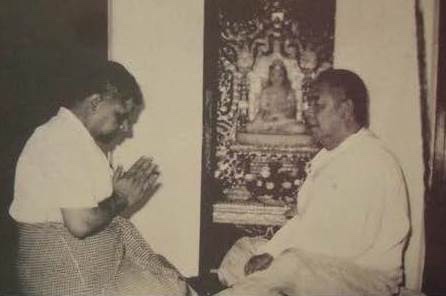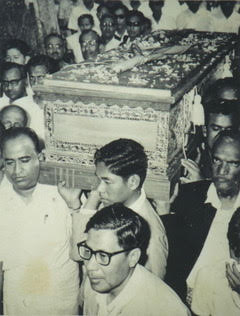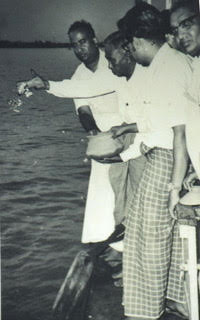As chief accountant of the Burma Railways Board, 42-year-old U Ba Khin (1899-1971) was auditing railway stations on the Rangoon-Mandalay line when his personal carriage was mistakenly detached at Kyaukse. He completed an unscheduled auditing of the station, and then visited the nearby Shwetharlyaung Hill to pay his respects to a renowned monk, Webu Sayadaw. That meeting had a long-term impact on India and the world.
Impressed with U Ba Khin’s progress in Vipassana meditation, Webu Sayadaw immediately exhorted him to share the ancient practice, which he had learned from a farmer teacher, Saya Thetgyi. The station master at Kyaukse became U Ba Khin’s first student. Within two decades, U Ba Khin, as independent Burma’s first accountant general, used Vipassana to reform four government departments, successfully fulfilling the anti-corruption mission prime minister U Nu had given him.
U Ba Khin conducted Vipassana courses within the office premises, before he established the International Meditation Center in Yangon. He realized that laws and punishments alone could not work. The anti-corruption war had to be fought in the mind, to gain the crucial realization that corruption is assured self-destruction. Decades later, government departments across India grant paid leave for officials to attend Vipassana courses.
Sayagyi U Ba Khin paying respects to Venerable Webu Sayadaw
U Ba Khin was a remarkable individual who opened the path of Vipassana to non-Burmese-speaking people, particularly Westerners. His exposition of Vipassana had a striking ring of truth, and he was the first English-speaking Vipassana teacher to explain the Buddha’s practical path in modern scientific terms.
“Sayagyi’s way was not the way of scholars,” said his foremost student Satya Narayan Goenka, a Myanmar-born industrialist of Indian ethnicity. “Every word that he spoke came from his own experience. Therefore his teachings have the life of experience within them.”
Kyaukse Railway Station - an unforgettable landmark in Vipassana history, from where Sayagyi U Ba Khin first began teaching
Vipassana, taught free of cost through residential courses in 336 locations worldwide, includes practitioners from diverse backgrounds – from heads of state such as Indian President Ram Nath Kovind, corporate chieftains, nuclear scientists, psychiatrists and schoolchildren to inmates of high-security prisons – New Delhi’s Tihar Jail and Donaldson Correctional Facility (see the trailer of the award-winning Dhamma Brothers) in Jefferson county, Alabama.
I have absolutely no doubt Vipassana is the single most powerful force of change of our times. For the country and our world to change for the better, the individual has to change. Vipassana enables the inner change.
The self-dependent practice breaks down the barrier of ignorance that prevents us from seeing reality within, instead of rolling in delusions, illusions. This ignorance of inner reality leads to unwholesome actions. Vipassana enables experiencing how the first victim of unwholesome thoughts, words, actions is oneself. So what’s the point of harming oneself?
As fire and water cannot co-exist in the same vessel, correct Vipassana practice cannot co-exist with corruption in the same mind. Corruption monitors such as Transparency International’s Corruption Perception Index paint a dismal picture, but statistics cannot tell us of honesty at work, of unnumbered times when people of unshakable integrity rejected temptations.
Despite perceptions of widespread corruption in India, I have never personally encountered a bribery demand to get any governmental work done.
U Ba Khin himself was a shining example of honesty. My teacher Sayagyi U Goenka recalled an inspiring incident during World War II:
“In 1942, Japan attacked Myanmar, and its bombers destroyed Mandalay Railway Station, where U Ba Khin was then the accounts officer. He saw that the station’s safe had not been damaged in the bombing raid. The senior railway officers, who were British, were intent on escaping to India. If U Ba Khin had kept the government money for himself, no one would have known about it. But he unlocked the safe, took out the contents, drove two hours by car and handed over the money to the senior-most railway officer, who was on the way to the airport. U Ba Khin had need of money at that time because his daughter was ill. But he did not want to keep even a penny that belonged to others. Such a selfless person, free of craving, was Sayagyi U Ba Khin.”
The Accountant General Office building in Yangon, Myanmar, where Sayagyi U Ba Khin first conducted 10-day Vipassana courses within the office premises.
In 1969, U Ba Khin authorized his distinguished student Satya Narayan Goenka to teach Vipassana in India, the country of its origin. This timeless practice, referred to in the Rigveda, was lost for millennia in India, primarily because of vested interests corrupting the practice by adding rites and rituals.
Conducting the first 10-day Vipassana course at the Pancayati Wadi rest house in South Bombay 50 years ago, Sayagyi U Goenka began teaching Vipassana in its non-sectarian, experience-based pure form. Not merely theories, intellectual debates, rites and rituals, but the actual practice to explore the truth within, to be aware with equanimity of the reality of who we actually are.
The first Vipassana centre for householder students, Yangon. Burma
Special courses being held this year to mark the 50th anniversary of Vipassana returning to India are a connection of links. India’s financial capital Mumbai that hosted the historic first course in 1969 has the greatest number of Vipassana practitioners in the world. Sayagyi U Goenka, instrumental in sharing Vipassana worldwide in more than 100 countries, was born in Mandalay, near Kyaukse where U Ba Khin began teaching. He lived in Mumbai, until he passed away peacefully there on September 29, 2013, aged 89.
He predicted that Vipassana would bring together India and China – both countries currently sharing poor Corruption Perception Index positions, ranked 78 and 87 out of 180 countries.
In links connecting Vipassana, India and China, The Statesman, whose office in Mumbai is near the venue of the first Vipassana course in 1969, and Asia Times, based in Hong Kong, have by my reckoning published the most articles on Vipassana in English-language media. The merits thereby gained are immeasurable for sharing this universal path to true happiness – beyond glittering traps of corruption of any kind.
(from an article originally published in Asia Times, Hong Kong)
***










